Blog
Automating Cyclical Work in Kanban for Higher Efficiency12 Nov 2025
In a typical knowledge-based work scenario, managing a Kanban board 100% manually works OK for the first few weeks — until one too many recurring task slips through the cracks, someone forgets to compile a weekly report, and you're knee-deep in reviewing items you already reviewed last Thursday. If this sounds familiar, it may be time to stop just dragging cards from “To Do” to “Done” for the hundredth time and start demanding a bit more work from the board itself!

Like many modern visual workflow platforms, Kanban Tool isn’t only a digital whiteboard for dragging task cards across. It includes powerful automation capabilities, such as Recurring Tasks and Process Automation rules, allowing you to set up the automation logic once and then let the system carry the load. Let's see how you can transform your Kanban board from a workflow tracker to a workflow operator.
1. Recurring Tasks for minimizing manual card creation
Adding the same task to the board every Monday morning might be a symptom of discipline, but it is also a sign of inefficiency. Kanban Tool’s Recurring Tasks let you plan auto card creation based on a fixed schedule — daily, weekly, monthly, or on specific dates.
Say you need to perform a system audit every Friday. Instead of manually adding the task, configure a recurring card:
- Assign it to the right person by default.
- Create a detailed checklist with standard required steps.
- Add tags for easier filtering and reporting.
- Define the start and due dates relative to each automatic instance creation.
Now, every Friday at 9 AM, a fresh card appears in the “Scheduled” column, pre-loaded, assigned, and ready in every detail. No missed audits, no reminders sent via text at 4:59 PM.
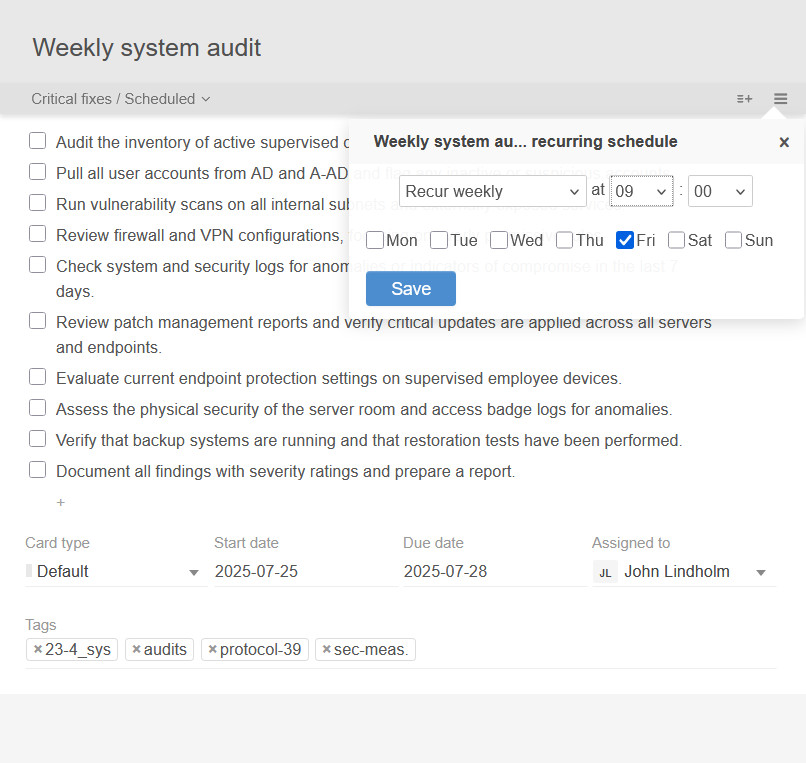
Be sure to create recurring cards also for personal productivity — e.g., weekly 1:1 prep, inbox zero reviews, or retrospective preparation. Routine is much more manageable when pre-assembled!
2. Leverage custom automation for trigger-based efficiency
Where Recurring Tasks handle the when, Process Automation rules deal with the if. Much as you define your workflow steps, it is also you who defines what should happen when specific actions or conditions are met.
Example A: Auto-archive completed reports
Rule: When a card with the tag “Monthly Report” is moved to “Done” archive it.
It will keep the board clean without requiring someone to sweep it manually.
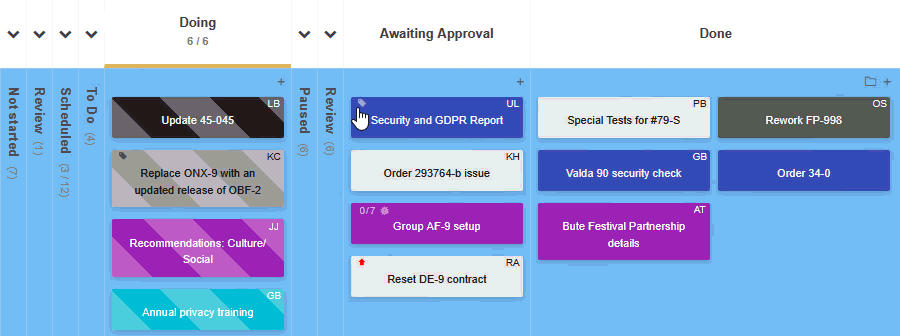
Example B: Escalate overdue approvals
Rule: If a card is in “Awaiting Approval” for more than 48 hours, assign it to the project lead, who will receive an email with this new assignment for their review.
It will reduce lag in bottleneck stages without the need for micromanagement.
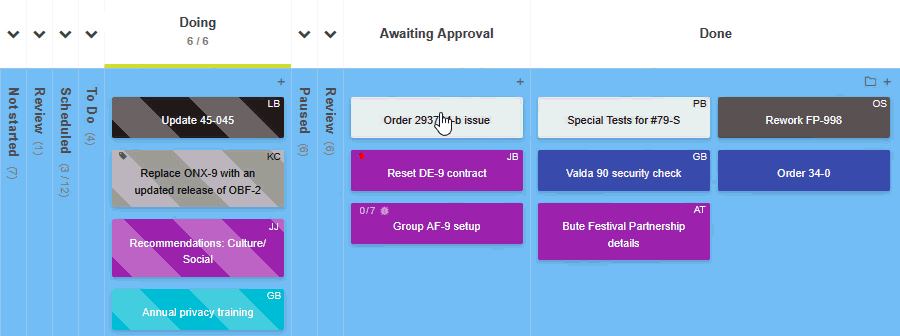
Example C: Auto-prioritize the backlog
Rule: When a high-priority card is created, slide it to the top of the “Not started” column and assign it to the triage team.
It will keep your triage queue self-regulating and responsive.
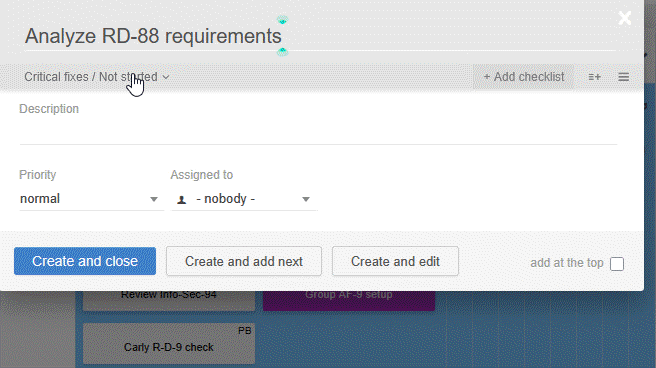
3. Automate notifications without creating noise
Not all reminders are treated equally - manual reminders can often be forgotten or ignored. Kanban Tool’s automation helps you send context-aware notifications triggered by behavior, rather than guesswork.
For instance:
- Notify stakeholders only when a card moves to “Needs Input”.
- Send reminders to the assignee when a card hasn’t been updated in X days.
- Automatically notify a reviewer when a card with “QA Required” is marked “Ready for Review”.
This behavior-driven approach reduces unnecessary chatter while surfacing the work that factually needs somebody's attention.
4. Reuse your custom cards and workflows
Take advantage of variable Card Templates to standardize task types. For example, every time a task is set to the “review” type/color, its field set can automatically adjust to only be equipped with the needed information type:
- Due and start dates
- Reviewer assignment
- A spot for attaching documents
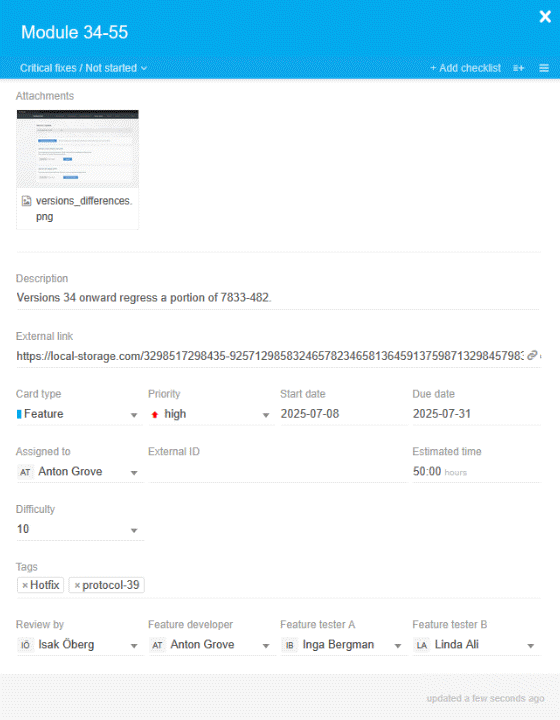
This is particularly powerful for high-work-pace environments with high employee turnover. With variable task templates, you're not just automating task creation; you're automating information quality control.
5. Refine with automated reporting
Automation isn’t only about execution, but also visibility. You can set up rules that automatically update tags, types, priorities, or that send custom reports as tasks are completed. These can fuel your process overview reports without any human intervention.
For example:
- Notify the card creator when their task is moved to “Reviewed”.

- Move cards with a tag “Compliance” to a dedicated swimlane once they're completed.

- Enable the daily Work Summary email to receive messages about the tasks you and/or your team have been working on today.
These subtle, no-effort notifications remove the friction between task execution and status reporting. No one has to ask, “Did we finish the quarterly review?” — the board already shows it.
Make the board your assistant
Too often, teams use Kanban boards as rudimentary, digital to-do lists. But a truly optimized board can do more than capture work — it can help you execute it — quietly, predictably, and without constant manual input. By leveraging Kanban Tool's Recurring Tasks and Process Automation rules, you can build workflows that self-start, self-monitor, and even self-correct.
We're not suggesting you replace human insight, but that you remove the mindless repetition that gets in its way. When done right, your board can turn from a tool to one of your team members! A team member who never forgets a task, never gets bored, and certainly doesn’t snooze throughout your Tuesday status update ;)

Sign up for a 14-day free trial
to test all the features.
Sign up now and see how we can help
your organization deliver exceptional results.